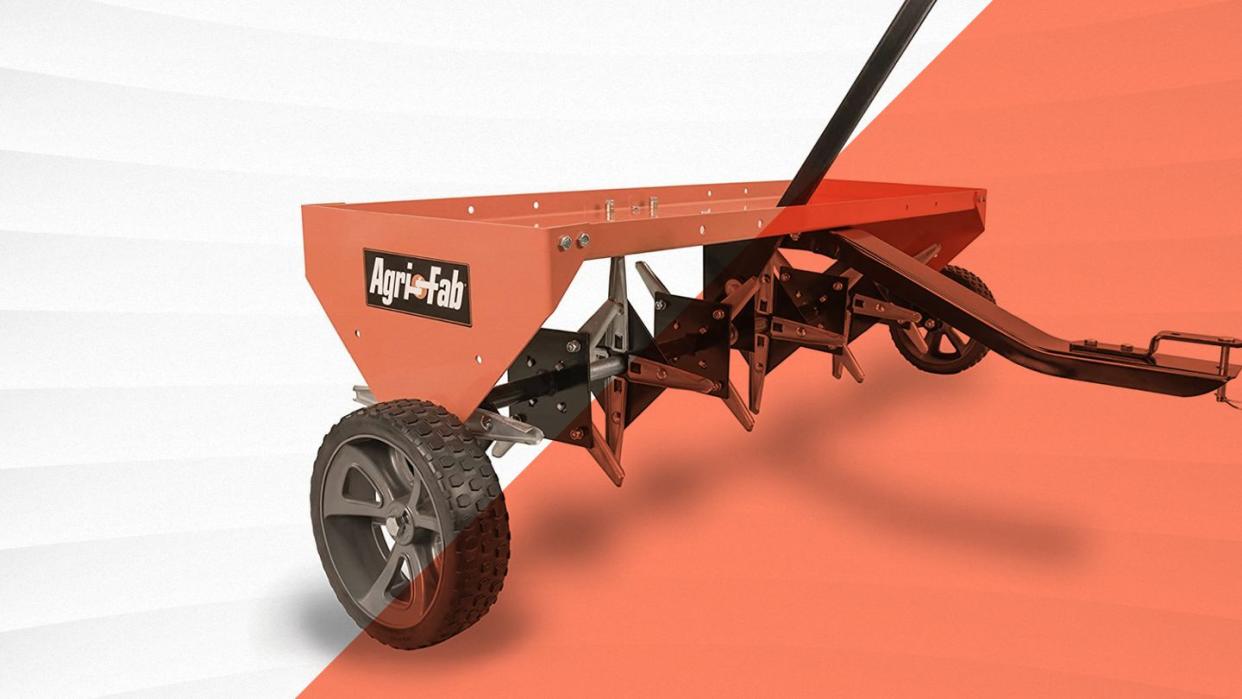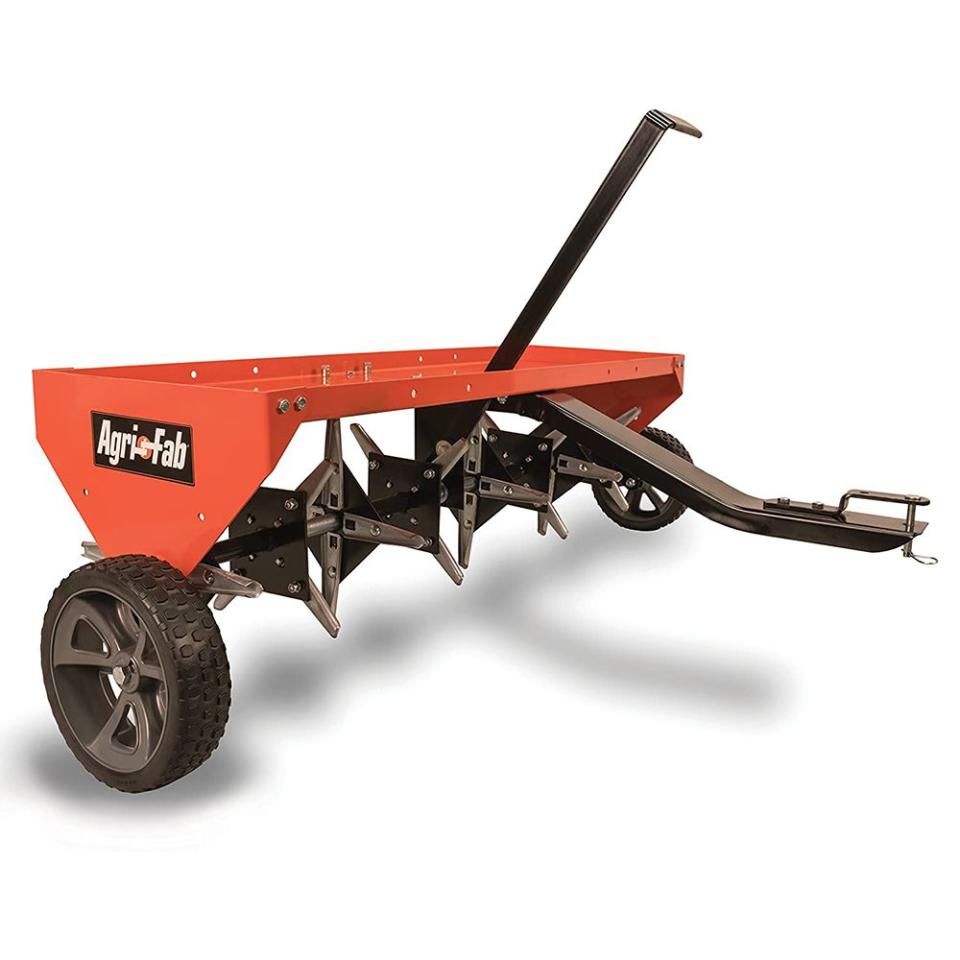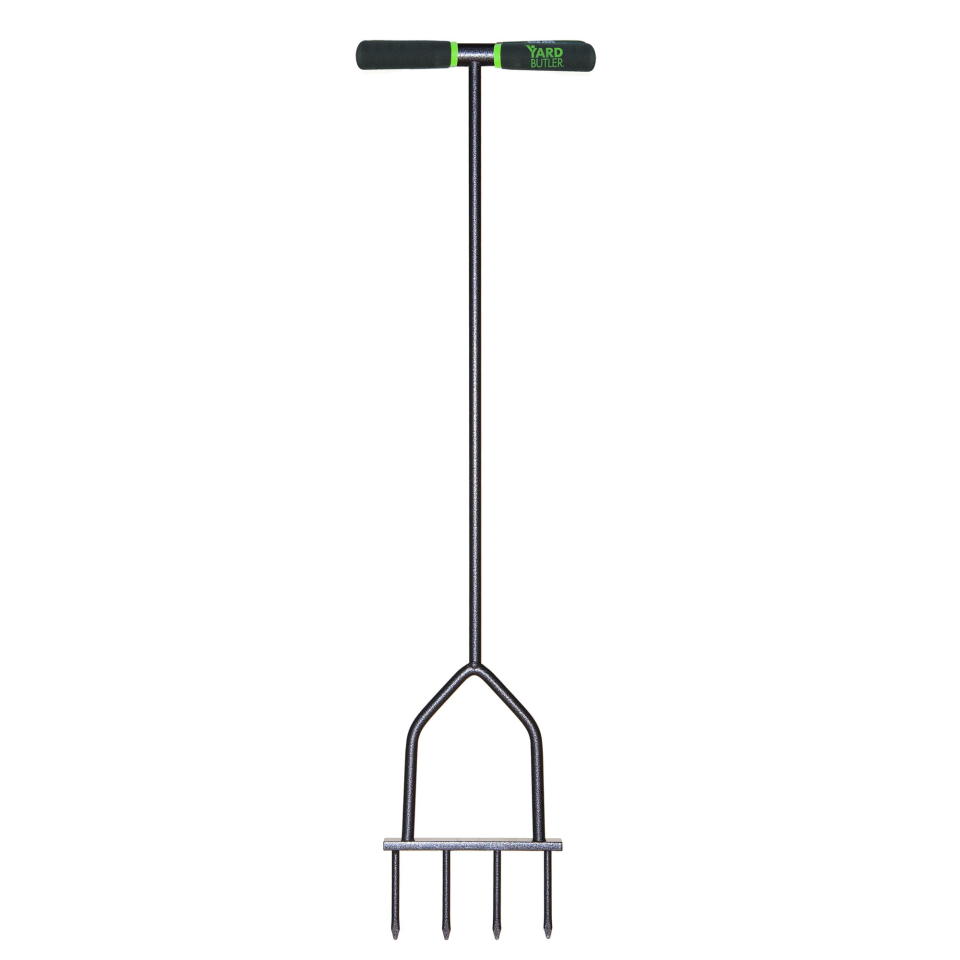These Lawn Aerators Keep Your Grass Healthy and Green

"Hearst Magazines and Yahoo may earn commission or revenue on some items through these links."
If your yard is made of heavy, clay-like soil that’s easily compacted, you could benefit from a lawn aerator. These tools remove small cores of soil, or create tiny holes in your lawn, to allow oxygen, nutrients, and water to reach the roots below. When combined with an effective watering program and proper fertilizer application, you can turn that patchy and discolored yard into a healthy and lush lawn.
We used our expertise in lawn care and landscaping and advice from turfgrass experts to select the best lawn aerators on the market. Read on for our recommendations, as well as what to keep in mind while shopping.
The Best Lawn Aerators
Best Push Spike: Agri-Fab 16-Inch Push Spike Aerator
Best Tow-Behind Plug: Agri-Fab 48-Inch Tow Plug Aerator
Best Tow-Behind Spike: Agri-Fab 40-Inch Spike Lawn Aerator
Best Handheld Core: Yard Butler Lawn Coring Aerator
Best Handheld Spike: Yard Butler Multi Spike Lawn Aerator
When Does Aeration Do for Your Lawn?
Aeration is the process of perforating the soil with small holes to allow air, water, and nutrients to penetrate deep into the root zone, promoting robust root growth and overall lawn health.
According to Trey Rogers, a professor and turfgrass management expert at Michigan State University, most people need to aerate their lawns for one of two reasons: soil compaction or an overproduction of thatch.
Thatch is a layer of partially decomposed organic material, usually grass, that accumulates on the surface of the soil. It is an issue because it acts as a barrier that prevents air, water, and nutrients from reaching the soil and roots.Rogers says the first step in choosing a lawn aerator is identifying if you’re aiming to get rid of thatch or to get rid of compaction. Some machines do both.
The causes for both compact soils and thatch include poor soil health, new soils (often in new subdivisions), overwatering, and over-fertilizing. Identifying the cause of soil or thatch issues can help prevent them in the future, and minimize how often you need to aerate your lawn—more on how to assess your lawn’s aeration needs below.
Aerating can be a labor-intensive task, and it isn’t something every lawn owner needs to do annually, if at all—nor with an expensive machine.“If you have a small patch of lawn, you can [aerate] with a pitchfork,” says Brooke Edmunds, an associate professor at Oregon State University’s department of horticulture. “It may not be as effective, but it can work. It is the same concept; you’re just creating space in the soil and breaking up the thatch.”
But for intense compaction and big lawns, mechanical is the way to go—these machines remove chunks of soil from your yard and “open up a space in the lawn for roots to grow,” Edmunds says.
“If you’re dealing with a compaction issue, you must be able to get a machine to punch a hole deep enough to actually do some good,” Rogers says. “What this often means is that it has to be mechanically driven.”
For folks who need the power of a mechanical aerator but don’t have the funds, space, or necessity to buy one, consider renting one from a garden or hardware store.
How to Tell If You Need to Aerate Your Lawn
Identifying if your lawn needs to be aerated involves assessing several factors and areas in your yard.
Soil Compaction: Walk across your lawn. If the soil feels hard and firm, or if you notice water pooling on the surface rather than soaking in, it may be a sign of compaction.
Thatch Layer: Examine the layer of thatch (a.k.a., dead grass and organic matter) between the soil and grass blades. If it's thicker than half an inch, it can hinder water and nutrient penetration, indicating aeration may be necessary.
Sparse Grass Growth: If your lawn has patches of thin or sparse grass growth, it may indicate soil compaction, poor drainage, or thatch buildup.
Heavy Traffic Areas: Lawns that receive heavy foot traffic, such as paths or play areas, are prone to soil compaction.
Water Runoff: Observe how water behaves during irrigation or rainfall. If water quickly runs off the surface instead of being absorbed, it suggests soil compaction.
How We Selected
Alex Rennie, the original author of this guide, spent years working as part of a professional landscaping crew and routinely aerated residential lawns and parks. He kept this experience in mind while assembling this list, combining his hands-on experience with extensive online research and making sure to exclude any low-quality options.
Additionally, we consulted with two experts—Trey Rogers, a professor and turfgrass management expert at Michigan State University, and Brooke Edmunds, an associate professor of practice in the department of horticulture at Oregon State University—to fully understand what the average person needs in a lawn aerator. We researched the best materials, methods, and aeration depths to find manual and mechanical machines that’ll work well on a wide variety of soil types.
We recommend a good mix of handheld, push, and tow-behind options, so regardless of your lawn size or physical ability, you should find a style that works for you. Some people have different budgets for lawn aerators, so this list includes a wide range of prices.
16-Inch Push Spike Aerator
The Agri-Fab 16-inch push spike aerator is reliable and efficient for maintaining a healthy lawn. Its sturdy construction and durable design make it well-suited for aerating small to medium-sized lawns. The 16-inch width allows for efficient coverage while maneuvering around landscaping features and tight corners.
One of the standout features of this push spike aerator is its simplicity. With no complex mechanisms or power sources required, it's a convenient option for homeowners looking to aerate their lawns without the hassle of gas or electric-powered equipment.
The spike aerator effectively penetrates compacted soil to create small holes, promoting air, water, and nutrient infiltration to the root zone. It would be nice if the tine depth were a bit deeper, but for small lawns this will get the job done. While it may not remove plugs like core aerators, it still provides adequate aeration for maintaining healthy grass growth.

16-Inch Push Spike Aerator
amazon.com
$51.30
48-Inch Tow Plug Aerator
The Agri-Fab 48-inch tow plug aerator is a robust and efficient tool for aerating large lawns. Its 48-inch width allows for wide coverage in a single pass, making it ideal for commercial landscapers and homeowners with expansive yards. The tow-behind design can be attached to a lawn tractor or ATV, reducing manual effort.
This aerator removes soil plugs from the lawn. The weight tray allows for customizable penetration depth, ensuring optimal results on different soil types. Constructed with durable materials, including galvanized steel, this aerator is built to withstand frequent use and harsh outdoor conditions. The flat-free tires provide added stability and maneuverability, while the universal hitch allows easy attachment to most lawn tractors or ATVs.

48-Inch Tow Plug Aerator
amazon.com
$379.00
40-Inch Spike Lawn Aerator
The Agri-Fab 40-inch spike lawn aerator offers a practical solution for aerating medium- to large-sized lawns. With its generous 40-inch width, this aerator covers ample ground in each pass. The spike design effectively penetrates compacted soil but isn’t the most effective in breaking up thatch or penetrating clay soils.
One of the notable features of this spike aerator is its durability. Constructed with sturdy materials, including heavy-duty steel, it provides reliable performance season after season. Additionally, the universal hitch allows for easy attachment to most lawn tractors or ATVs.
While the spike aerator may not remove soil plugs like a core aerator, it still offers significant benefits for soil health and lawn vitality. It is suitable for users seeking a cost-effective aerating solution without the complexity of powered equipment.

40-Inch Spike Lawn Aerator
amazon.com
$175.85
Lawn Coring Aerator
The Yard Butler lawn coring aerator is a compact and efficient tool. Its simple yet effective design features hollow tines that penetrate the soil, removing plugs of dirt and thatch. Though it’s a handheld model, this tool is designed with comfort in mind thanks to a pair of cushioned handle grips and a foot bar that lets users control how deep the corers go. Each plunge removes two half-inch cores 3.5 inches long, conveniently ejected from the top of the cylinder.
Its small size and maneuverability make it ideal for aerating hard-to-reach areas or lawns where larger aerators may be impractical. Although it’s not as productive as tow-behind or machine options, this model’s durable steel frame and lack of moving parts make it a valuable, long-lasting tool. This is an excellent choice if you have a relatively small yard and don’t mind putting in some physical effort.

Lawn Coring Aerator
amazon.com
$43.99
Lawn Spike Aerator
The Yard Butler multi-spike lawn aerator is a versatile and efficient tool featuring multiple spikes. Unlike core aerators, the spike design minimizes soil disruption, making it suitable for frequent use without causing excessive damage to the lawn.
Its sturdy handle and lightweight construction provide comfortable operation and reduce strain on the user’s arms and back. Its compact size and maneuverability make it ideal for aerating smaller lawns or tight spaces where larger aerators may be impractical.
A wide foot bar allows you to easily sink the four 3-inch spikes into the grass with each plunge, and its cushioned handle reduces slipping and helps you maintain a sturdy grip while you work. This design can also hang on the wall, making it an excellent choice for those who don’t have much storage space.

Lawn Spike Aerator
walmart.com
$45.99
What to Consider When Buying a Lawn Aerator
Manual Versus Mechanical
There are many different types of aeration tools, from heavy-duty machines to affordable manual options.
Manual aerators are ideal for small lawns. You use them by pushing or stepping on the device to penetrate the soil. While they require more physical effort, manual aerators are more affordable and perfectly suitable for occasional lawn maintenance.
Rogers cautions that when you aerate is especially important if you are using a manual aerator. “How uncompacted your soil is or how wet or dry the soil is can impact how effective the tools are,” he says. “You can only get the proper depth with a handheld tool with loose soil or after it rains, so the soil is wet enough to penetrate.”
Tow-Behind Lawn Aerators
For larger lawns or frequent aerating needs, powered aerators such as gas-powered or electric models are more efficient. They’re usually designed like push lawn mowers and require less manual labor to cover larger areas quickly.
Tow-behind aerators are more affordable than gas-powered models and work well to cover large lawn areas quickly. They attach to the trailer hitch on your lawn mower or ATV, reducing physical strain on the operator, and function automatically when you move the vehicle forward and weigh down the tray (more on that in a moment). They’re most effective when aerating large, open spaces where uniformity is important.
Manual Aerators
While mechanically driven aerators may be the most effective, manual handheld or push options are also acceptable for spot treatments, tight spaces, small to medium lawns, and supplemental aeration between full aeration.
Handheld aerators typically feature a T-handle or similar grip that allows users to hold and operate the tool with one hand. They often have a single or few spikes or tines for penetrating the soil. They are best suited for spot aerating small areas or treating isolated problem spots in the lawn. They offer greater precision and control but are more labor-intensive for large areas.
Push aerators have a larger frame with two handles and are designed to be pushed across the lawn, usually with two hands like a push lawn mower without the engine. They typically have a larger aerating mechanism, such as a row of spikes or a rolling drum with spikes, and work well for large sections of open lawns with minimal obstacles.
Handheld and push aeration tools are versatile and practical for addressing specific needs, providing homeowners an affordable way to maintain healthy turf.
Width and Maneuverability
The best width and maneuverability for a lawn aeration tool depends on factors such as lawn size, terrain, and personal preference.
The width of the aerator should be proportional to the size of your lawn, with wider aerators covering larger areas more quickly—it’s helpful to know the square footage of your yard as you start shopping to estimate how many passes one aerator will take to cover your yard.
A narrower, handheld aerator may be more maneuverable and better suited to navigate tight spaces. Widths between 16 to 48 inches are commonly used for smaller lawns or areas where you need to maneuver around lots of obstacles like trees or flower beds.
When considering maneuverability, look for aerators with features like adjustable handles or swivel wheels that allow for turning around obstacles. Lightweight aerators are generally easier to push and maneuver, especially for users with limited strength or mobility, but this is less of a concern for towing or mechanical aeration.
Materials
Look for aeration tools made from materials that promote durability. Stainless steel and galvanized steel are among the top choices due to their resistance to rust and corrosion, ensuring longevity even in harsh outdoor conditions.
The strength of these materials makes them suitable for penetrating tough soil and compacted turf without bending or breaking. Additionally, stainless steel and galvanized steel aerators provide smooth operation, allowing for efficient aeration with minimal effort.
Another popular option is high-quality plastic, known for its lightweight design and ease of use. While plastic lawn aerators may not offer the same level of durability as steel, they are still effective for aerating small to medium-sized lawns.
Plastic aerators are typically more affordable, making them a budget-friendly option for homeowners.
Some tow-behind aerators also have additional durability features like flat-free tires. Flat-free or puncture-proof tires are usually made of solid rubber or have a unique construction that prevents air from escaping even if the tire is damaged. Flat-free tires are most useful when aerating rough or uneven terrain where traditional pneumatic tires may be susceptible to punctures from sharp objects like rocks or debris.
Core Versus Spike Aerators
There are two types of lawn aerators: core aerators and spike aerators.
Plug or Core Aerators
Plug aerators punch into the ground and remove small plugs of soil from the ground, creating cylindrical openings for air and water infiltration. This type of aerator is more effective at relieving soil compaction and is recommended for heavy clay soils.
If you use a core aerator, Edmunds advises, “you’ll have to go back and rake up the cores of soil. If you leave the cores, they can shade the grass and leave muddy patches.”
Tine or Spike Aerators
These aerators feature solid spikes that puncture the soil to create holes. While they’re generally less expensive, spike aerators can cause soil compaction around the holes, potentially exacerbating soil density issues.
“They’re not removing soil,” Edmunds says. “They are creating space for better airflow and water access.”
Tine aerators are best for light aeration and regular lawn maintenance, while core aerators are better for deeper soil penetration and addressing more severe soil compaction issues. Ultimately, you can choose between the two based on budget and the general needs of your lawn.
Aeration Depth and Spacing
For deeper lawn aeration, choose an aerator with adjustable penetration depth to customize according to soil conditions and grass type. Typically, a 3-inch depth is the most effective, but you can go deeper if your lawn is extremely compacted.
Other features, like a weight tray, can impact the depth of penetration. A lawn aerator’s weight tray is typically found on tow-behind or push-style aerators. It’s a tray or container located on the aerator that allows you to add weights such as sandbags or concrete blocks.
By adding weight to the tray, you increase the downward pressure applied to the tines or spikes that penetrate the soil during aeration. This increased pressure helps the aerator effectively penetrate compacted soil, allowing for deeper and more thorough aeration.

You Might Also Like

